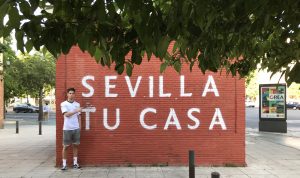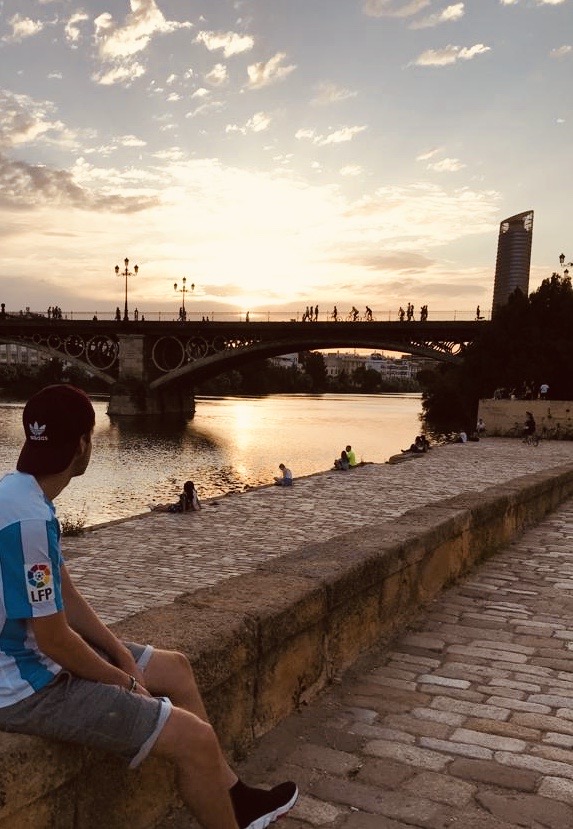
In Sevilla the month of June is when it begins to get really get hot. While it usually only gets above 40 in July, June is still incredibly warm with constant temperatures of over 35 degrees Celsius. While getting a haircut I quizzed my barber on how he puts up with this every year, to which he answered, “we aren’t used to it, but rather we are resigned to it”. I found myself drastically changing my diet as the heat made it more difficult than usual to digest big meals. Pasta and pizza had to be replaced with salmorejo and gazpacho.
Given that this was my last month in Sevilla, I was eager to see all the attractions that I had so far not got around to visiting. I started by taking a trip to the Metropol parasol or as it is also known, ‘Las Setas de Sevilla’. The former translates to ‘the mushrooms of Seville’, which refers to the resemblance that the large, curvaceous structure has to a mushroom. Designed by German architect Jurgen Mayer, it was inaugurated in 2011 and has since become one of the most imposing pieces of architecture on the Sevillian skyline. In contrast to the rather traditional buildings it finds itself sitting next to, ‘Las Setas’ is strikingly more modern and almost out of place. Yet it manages to remain refined and typical of the standard of architecture that you’d expect to find in Sevilla. It also has a platform at the top which gives locals and tourists the chance to get a great view of the whole City. With my mask on I entered the structured and made my way to the top. I realised that I had never seen the city from this perspective, given that Sevilla is so flat. The industrial, working class macarena region to the north. The architecturally rich centre to the south. It was quite something to be able to see over the whole city and compare its different parts.
Next on my list was the famous Real Alcázar. Located in the historic centre, it is globally renowned for its beauty and grandeur. The site was originally developed as a fort in 913 but has since been revamped several times, most notably under the reign of King Pedro when the spectacular Palacio de Don Pedro was added. Walking through the Alcázar, I could not help but find myself in awe of the sheer size of the palace. Just when you think you have explored the whole site, you turn a corner and another elaborately decorated patio will appear.
My visit to the Alcázar was also the perfect time for me to reflect on my 9-month stay in Sevilla. The complex but stunning design of the palace somewhat mirrored my own experiences in Sevilla. A city steeped in beauty, but which also provides unique challenges, especially to those who are not locals. I feel that these challenges have helped me to grow as a person and have given me a profound and valuable insight into a culture which stands alone not only globally but also to some extent in Spain.

En Sevilla, el mes de junio es cuando empieza hacer calor de verdad. Mientras que normalmente solo supera 40 grados en julio, junio todavía es increíblemente caluroso con temperaturas constantes de mas de 35 grados. Mientras que me estaban cortando mi pelo en una barbería, Pregunté a mi barbero como podría soportarse esto cada ano, a lo cual me respondió que “no estamos acostumbrados, sino estamos resignados. Personalmente estaba cambiando mi dieta dramáticamente dado que el calor lo hacía mucho más difícil que normal digerir los platos grandes. Pasta y pizza, fueron sustituidas por salmorejo y gazpacho.
Dado que esto era mi último mes en Sevilla, tenia ganas de ver todas las atracciones turísticas que hasta aquel momento no había tenido el tiempo para visitar. Empecé con una visita al metrópol parasol, también conocido como las setas de Sevilla. Lo cual refiere a la semejanza que la gran y curvilíneo estructura tiene con una seta. Designado por el arquitecto alemán Jürgen Mayer, fue inaugurado en 2011 y desde aquel momento se ha convertido en una de las piezas más imponente sobre el horizonte Sevillano. En Contraste con los edificios bastantes tradicionales que se encuentre a su lado, las setas son notablemente más modernas y casi fuera de lugar. Pero logra seguir siendo refinado y típico del estándar de arquitectura que se espera encontrar en Sevilla. Además, tiene una plataforma encima que lo da una gran oportunidad a las turistas para ver toda la ciudad. Con mi mascarilla puesta, entró el sitio y me dirigí hacia la parte de arriba. Me di cuenta de que nunca había visto la ciudad de esta perspectiva, Dado que Sevilla tiene un terreno muy llano. El barrio industrial y obrero de Macarena al norte. La riqueza de arquitectura del centro al sur. Fue algo impresionante ver toda la ciudad y comparar sus partes diferentes.
Lo que seguía en mi lista era el famoso Real Alcázar. Localizado en el centro histórico, es conocido mundialmente por su belleza y grandeza. El sitio originalmente fue construido como una fortaleza, pero desde aquel momento ha sido renovado varias veces, mas notablemente bajo el reino del Rey Pedro cuando fue construido el espectacular palacio de Don Pedro. Caminando por el Alcázar, me sentía asombrado por la mera magnitud del palacio. Justo cuando uno se cree que ha explorado todo, se gira una esquina y otro patio decorado elaboradamente aparecerá.
Mi visita al Real Alcázar era también el momento perfecto para reflexionar sobre mi estancia de nueve meses en Sevilla. El diseño complejo pero asombroso en cierto modo reflejó mi experiencia personal en Sevilla. Una ciudad llena de belleza, pero que también proporciona dificultades únicas, especialmente para la gente que son nativos. Me siento que estos desafíos me han ayudado crecer como persona y me han dado un conocimiento profundo y valioso sobre una cultura que es único no solo en el mundo, pero hasta un cierto punto también en España.
